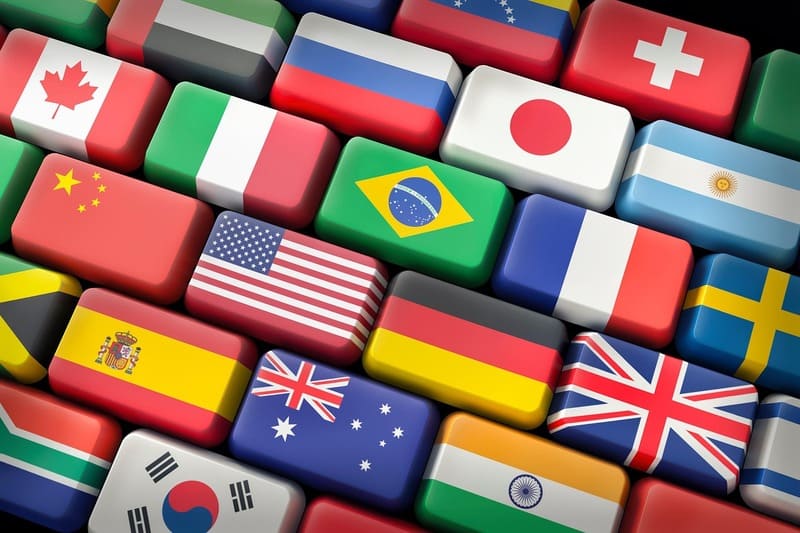In the era of globalization, every sector competes for a place in the international market. The Southeast Asian market, spanning business, education, health, and technology, is no exception.
Southeast Asia has emerged as one of the world’s most dynamic regions, full of untapped potential. One effective way to tap into this potential is by leveraging translation and localization. Why is this service important?
The Southeast Asian region is a rich tapestry of diverse cultures and traditions. Just imagine traveling from Indonesia to Malaysia, then to the Philippines, and finally to Thailand. Despite being in the same region, these four countries boast vastly different cultures. To effectively connect with your target market, you need the aid of translation and localization services.
However, the task of translation and localization in Southeast Asia is not without its challenges, particularly due to the region’s unique traditions and cultures. For example, Indonesians greet with “Selamat pagi” or “Apa kabar?”, while Thais say “Sawadee,” followed by “kha” (for women) or “krub” (for men).
This underscores the importance of working with a competent, experienced translator who possesses extensive knowledge of the region. Such experts ensure your localization is not only accurate but also culturally relevant to your target market.
Why Southeast Asia Is a Translator’s Puzzle Box
Southeast Asia, a region in the southeastern part of the Asian continent, occupies a highly strategic position. This is because the region lies between two major oceans—the Indian Ocean to the west and the Pacific Ocean to the east.
Furthermore, Southeast Asia is located between two large continents: Australia to the south and Asia to the north. This position has made the region a key international trade route from ancient times to the present day. This intersection has made Southeast Asia a melting pot of cultures.
Foreign cultures that entered the region blended and evolved alongside local traditions. For example, Indonesia has hundreds of languages and dialects. A single ethnic group, such as the Javanese, has its own distinct dialect.
The Philippines has 170+ dialects, Malaysia mixes four languages, Vietnam has three, and Myanmar varies by ethnicity. The richness of languages and dialects in this region is also influenced by colonialism. Each country has its own colonial history. For example, Indonesian languages are influenced by English, Portuguese, and Dutch.
Furthermore, writing systems differ. For example, the Thai writing system is very different from the Indonesian one. This is what makes the linguistic landscape of Southeast Asia so rich.
Meanwhile, the oral traditions and cultural traditions of the communities in this region remain very much alive. Examples include the Philippines’ Bugtong and Salawikain, pantun in Indonesia and Malaysia, and Buddhist folktales in Cambodia.
Tradition in Every Sentence — How Culture Shapes Word Choices
In translation and localization in Southeast Asia, a translator must understand the region’s culture. The culture of the region, including its customs, norms, and social hierarchies, is inseparable from this process.
Furthermore, many ethnic groups and cultures in Southeast Asia have their own levels of politeness. Translators should be mindful of these levels to avoid violating social norms.
For example, the Javanese in Indonesia implement levels of politeness, namely kromo, madya, and ngoko. The kromo level is used for older or respected individuals. Madya is used for those with whom one is less familiar but does not necessarily require respect.
Ngoko is used when speaking with close friends, peers, or younger people. Furthermore, politeness levels also determine the tone of your speech. Speakers use a softer tone in kromo, while ngoko allows for a more relaxed and informal manner.
In addition, translators must also understand the concept of collectivism in Southeast Asia. Through this concept, translators must know that people in this area prioritize community, family, and social harmony over freedom or personal interests.
For example, the culture of cooperation (gotong royong) in Indonesia, the application of values of good character and respect, which foster mutual respect and maintain group harmony, or the concept of “kreng jai,” which teaches a reluctance to inconvenience others.
The unique cultures of each Southeast Asian country require extra care in word choice during localization. Choosing the wrong word can diminish the meaning and even violate local decency, norms, and laws.
Localization Isn’t Just Translation — It’s Cultural Adaptation
People often think translation and localization are the same. In fact, there’s a significant difference. Translation is simply the process of conveying words from one language to another, making sure the message remains understandable.
But localization goes much deeper. It adapts the message, style, and even emotions to make them feel “connected” to the local culture. Imagine translating a Japanese game into Indonesian.
If it’s just a translation, you might change the dialogue. But with localization, you also consider things like humor, food, or cultural symbols that might be unfamiliar here. For example, a joke about winter might be changed to something closer to the experience of Indonesian players, perhaps about the rainy season or traffic jams in big cities.
The same applies to products and media. A successful beverage advertisement in America could fail miserably in Southeast Asia if it’s not localized. For example, the US allows a soda brand to feature children drinking soda at an event, whether it’s a birthday party or a family picnic.
However, in some Southeast Asian countries, advertisements showing children drinking soda are prohibited by health regulations. This is based on government regulations that consider them to pose potential health risks to children.
Furthermore, product color selection is crucial. While yellow symbolizes cheerfulness and optimism in Europe, in Malaysia and Thailand it represents royalty, making it unsuitable for casual or commercial use.
This color is considered royal in both countries. Therefore, its use in commercial products could be regarded as disrespectful if it is careless. Localization isn’t just about language; it’s about feeling. It connects global messages with local values.
When Culture Talks Back — Stories from the Ground
In Southeast Asia, culture isn’t just a backdrop; it’s a living voice, often “talking back” when words are translated without understanding their more profound meaning. Translators, content creators, and game developers in the region know all too well that translation isn’t just about language, but also about feeling.
Companies like Speequal and Speequal Games illustrate how cultural sensitivity plays a crucial role in real-world localization projects. In the process of localizing games, they often encounter terms or humor that sound natural in English but feel foreign, even offensive, in the local context.
Conversely, local cultural elements such as pantuns (rhymes), traditional foods, or polite expressions can enrich the player experience, as long as they are presented correctly.
For example, a game developer from Bandung, Indonesia, created a horror game called DreadOut. This game features local Indonesian ghosts, a genre previously rarely used in horror games.
By highlighting local folklore, the game resonated deeply with Indonesian players and gained significant local traction. This is because it makes users feel close and connected to the ghosts featured in the game. However, the localization process preserved the core gameplay experience, ensuring a seamless player journey.
When culture “talks back,” creators learn to listen. Because in every word choice, there’s a bridge between the global world and local voices.
The Digital Shift — AI and Human Intuition in Localization
In recent years, translation and localization in Southeast Asia have undergone a significant digital transformation. The emergence of artificial intelligence (AI)-based translation tools, such as CAT tools or Machine Translation Post-Editing (MTPE), and adaptive localization platforms, has transformed the way companies communicate across languages and cultures.
Southeast Asia, with its linguistic diversity and rapidly growing digital economy, is a natural laboratory for the collaboration between technology and human expertise.
AI-based translation tools can now process large volumes of multilingual content at high speed and with high accuracy, providing efficient solutions for businesses expanding into markets such as Indonesia, Thailand, Vietnam, and the Philippines.
However, cultural nuances, local expressions, and the emotions in language still require sensitivity and contextual understanding from human translators and localization experts.
Rather than replacing human translators, AI will act as a powerful collaborator that enhances productivity while preserving cultural nuance. Professionals are now leveraging AI as creative assistants, handling repetitive tasks while humans refine the tone, cultural context, and authenticity of the message.
This hybrid approach bridges the digital communication gap in this linguistically diverse region. As Southeast Asia’s digital transformation accelerates, balancing machine precision with human intuition will be key to successful localization in the new era.
Localizing Games and Media Across Cultures
In the modern creative industry, translation and localization play a crucial role in bridging global cultures. When a game, film, or app is released to international markets, simply translating the text isn’t enough.
The localization process adapts all elements, from language and symbols to communication styles and cultural values, to make the user experience feel natural for the local audience.
A clear example can be seen in the localization of mobile games in Southeast Asia. Popular games like Genshin Impact not only translate dialogue into Indonesian, Thai, and Vietnamese, but also adapt dialogue, character costumes, and reward systems to suit local norms and tastes.
Some characters are given more modest attire in certain regions, while reward systems are adapted to local customs, such as daily login bonuses that mimic holiday gift-giving traditions.
Companies like Speequal Games, along with numerous local startups in Indonesia and Malaysia, are now focusing on authentic game localization and voice-over services. They collaborate with scriptwriters, voice actors, and cultural experts to ensure localization is not only linguistically accurate but also emotionally engaging for players.
Localization enhances the gaming experience by making it more relevant to users, as it is more familiar to the target market. Furthermore, this localization process also avoids regulatory restrictions in the target market.
Through translation and localization, games and media not only transcend language barriers but also build deeper cultural connections. This strategy is key to the global success of many entertainment products, demonstrating that cultural adaptation is a form of respect for international audiences’ diversity.
Shared Values, Different Voices — The Southeast Asian Advantage
The cultural and linguistic diversity of Southeast Asia is not just a challenge; it’s a unique and intriguing source of competitive advantage. In a region with hundreds of different languages and value systems, translators, creators, and communication professionals are accustomed to navigating meaning across cultures. This ability fosters a natural cultural intelligence that is highly sought after in the era of digital globalization.
In the context of translation and localization in Southeast Asia, the region’s workforce stands out for its sensitivity to cultural nuances. This cultural agility enables them to localize global messages with precision—preserving both brand integrity and cultural authenticity.
In the fast-paced world of digital business, the ability to connect technology with cultural context is not just a skill but a strategic asset.
The relationship between culture, business, and technology is becoming increasingly close, and Southeast Asia is at the forefront of this convergence. Companies operating in the region are learning that digital success depends not only on technical innovation but also on a deep understanding of human diversity.
Southeast Asia’s unique advantage lies in its ability to unite diverse voices into a shared narrative, rooted in values, yet open to global change. This embodies the principle of ‘think globally, act locally’ — and Southeast Asia exemplifies it best.
Meaning, Memory, and Mutual Understanding
Language is not just a means of communication, but also a vessel for meaning, identity, and collective memory. Every word holds traces of a society’s history, values, and perspective on the world. In Southeast Asia, with its rich cultural and linguistic diversity, translation and localization processes are crucial bridges to ensure that this richness of meaning is not lost in the currents of digital globalization.
Through localization, digital text and content are adapted to local nuances, enabling messages to be more deeply understood by local communities. Translators and localization experts play a crucial role in this process, as it not only creates broader access to knowledge but also strengthens mutual understanding between nations.
Thus, translation and localization in Southeast Asia serve not only as tools for cross-linguistic communication but also as a means of preserving cultural memory and building bridges of empathy.
In the localization process, it’s essential to choose a company with a professional and expert team. With over a decade of experience, SpeeQual Games has become a trusted partner in Southeast Asian game localization. With a team fluent in 11 Southeast Asian languages, we can help make your game relevant to your target market. Get ready to be relevant to your target market with SpeeQual! Contact us for further consultation!





